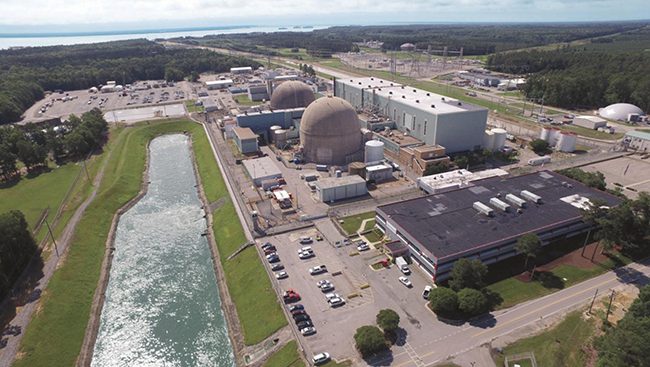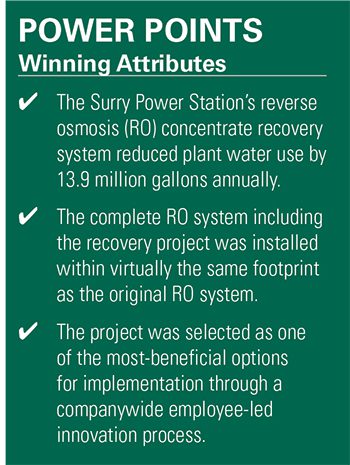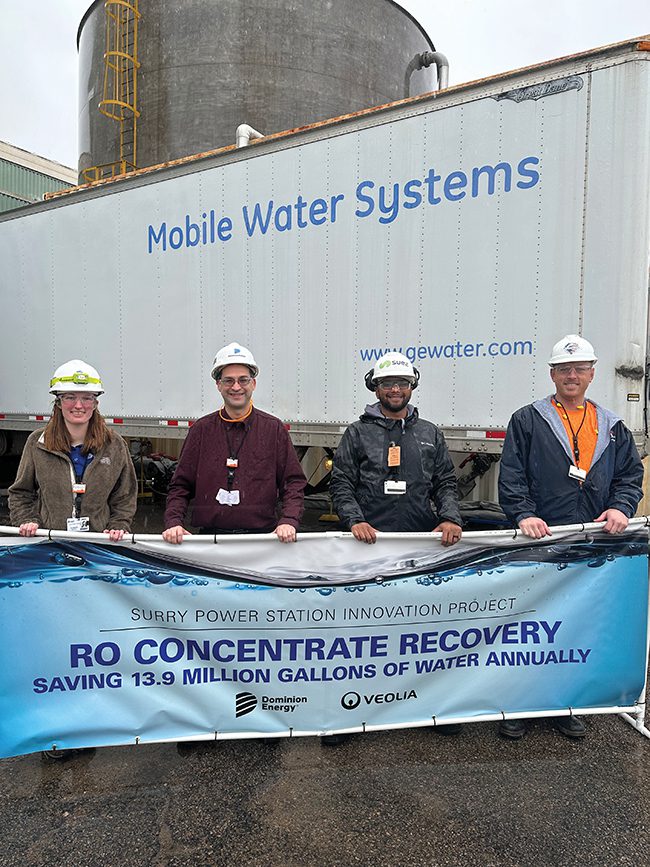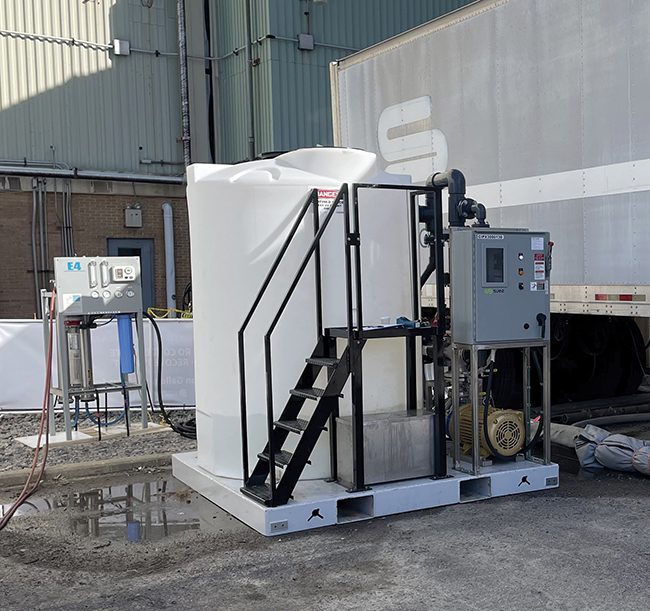Dominion Energy’s Reverse Osmosis Concentrate Recovery System Wins POWER’s Water Award

Sustainability and corporate responsibility are hugely important to power companies and their stakeholders today. When employees take these initiatives to heart and implement innovative ideas, goals can be met sooner rather than later.
In October 2020, Dominion Energy released its 2019 Sustainability and Corporate Responsibility Report, which covered the company’s initiatives across a range of areas—from safety and environmental management to diversity and employee benefits. At the time, Thomas F. Farrell II, executive chairman of Dominion Energy, said in a statement, “We live in a period of remarkable industrial, environmental, and social change. Our company is not only accepting that change, we are embracing it and leading the way.”
Among Dominion Energy’s major commitments detailed in the report were goals of achieving net-zero carbon and methane emissions by 2050 for both its electric and natural gas businesses. The company said it was investing aggressively in renewable energy production and other emissions reduction programs, including developing the largest offshore wind project in the Americas and adding more capacity to what was already the third-largest solar portfolio among utility holding companies in the U.S.
Perhaps flying a bit under the radar, but no less important than the other commitments detailed in the report, was a clean water goal to “Reduce 21 million gallons of water over the next five years.” Among the people focused on that particular commitment within Dominion Energy was Jonathan H. Warren, Business Development Manager, who at the time of the project was an Innovation Guide / Chemist III and served as the Project Champion. Warren was specifically asked by the site vice president of Surry Power Station to identify some options for cutting water usage at the plant.
Sustainable Nuclear Power
The Surry Power Station is a dual-unit nuclear power plant. Each unit has a three-loop Westinghouse pressurized water reactor. Together, the units are capable of supplying 1,676 MW to the grid, or about 15% of the electricity Dominion Energy customers receive. The facility is located in southeastern Virginia, on the south bank of the James River across from historic Jamestown, the first permanent English settlement in North America. The plant is also located adjacent to the Hog Island Wildlife Management Area, a state-maintained property.
The Surry station is an important part of Dominion Energy’s sustainable power generation portfolio. Nuclear units are, of course, carbon-free power sources, which are also highly reliable and can operate 24/7/365. Surry Power Station has operated at annual capacity factors greater than 90% more often than not over the past decade. In the summer, when according to the U.S. Energy Information Administration electricity loads are typically higher, it achieved greater than 99.5% in 2016 and was over 98% in 2017, an incredibly impressive two-year stretch of operation.
Dominion Energy believes so strongly in Surry’s value to its customers as a safe, reliable, carbon-free source of energy that it applied for subsequent license renewals (SLRs) for both units and received approval to operate them through 2052 and 2053, respectively. Surry is the only nuclear power station in the nation currently approved to operate to 80 years.

One Big Area for Improvement
Warren decided to take a good look at the amount of water being used at the Surry station, focusing specifically on the water used by the station’s reverse osmosis (RO) system. As most POWER readers know, all thermal power stations, including nuclear plants, require high-purity water for operation. RO systems are one common method used to reduce unwanted minerals, salts, metals, and other impurities from water used at these plants.
In simple terms, the RO process involves pushing feedwater through a tightly woven membrane that looks virtually impermeable to the naked eye. The membrane acts as a barrier to contaminants, allowing only a very small percentage of contaminants to pass through. In the process, there are two streams of water. The “permeate” is the stream of treated water, while the “concentrate” or “brine” is the stream of reject water, which is typically a waste stream.
Although the equipment had changed over time, Surry had used the original RO methodology, technology, and technique for approximately 50 years. Warren believed there had to be a way to reclaim and reuse at least some of the concentrate being discharged from the RO system. He contacted Veolia for help and decided to partner with the company’s experts to develop a plan.
“Together we came up with a small-scale pilot that acted as a mini reverse osmosis concentrate recovery system,” Warren told POWER. The biggest challenges would be demonstrating the new technologies and gathering resources to test the process.
Dominion Energy showcases innovation ideas through its “Spark Tank” initiative, a competition that recognizes the best new ideas from employees. Warren, who served as Project Champion for the project, submitted the RO recovery concept to be evaluated through that program. In the end, it earned third place in the company’s Eastern Regional Competition.
In addition to the site vice president’s attention, the Spark Tank recognition got Warren’s project in front of the Nuclear Innovation group (a special division within Dominion Energy that identifies and helps implement technology to improve performance and efficiency, and reduce cost), and Envision Tomorrow (another group within the company that is intended to help people work smarter, using employee ideas that lead to efficiency, create current or future savings, improve processes, and optimize workflows). The collaboration helped get Warren funding for a prototype system. Later, after the concept was proven, the groups helped get funding for full-scale implementation. “The pilot was successful, and we worked with Veolia to implement a full-scale project,” Warren said (Figure 1).
 |
|
1. Team members of Surry Power Station’s RO Concentrate Recovery Project are shown here following full-scale implementation of the system. From left to right are Corbin Hanny, Engineer I, Dominion Energy; Jonathan Warren, Business Development Manager, Dominion Energy; Xavien Ross, Field Service Representative, Veolia; and David Gibson, Field Service Representative, Veolia. Courtesy: Dominion Energy |
Working Within the Given Footprint
Veolia engineered the project and provided the necessary equipment. “Originally, we thought that stacking one RO on top of another would be effective, but as the details were worked out, this option was overly complex,” Warren explained. “We reworked the idea to keep as close as possible to the original footprint by adding to the existing system and adding the use of an antiscalant.”
Although both ideas were good, Warren said the cost and desire to stay within the existing footprint contributed to the final design chosen. In the end, the result was cheaper than the team had originally expected.
The project took about 18 months from first pitch to pilot (Figure 2), and then through full-scale installation. The pilot project did not require a design change, but the full-scale implementation did. Corbin Hanny, an Engineer I with Dominion Energy, performed the design change work. There was also about a one-month delay due to supply chain issues.
 |
|
2. The pilot used a small-scale replica of the new reverse osmosis (RO) system to test several variables to come up with the best configuration for full-scale implementation. Courtesy: Dominion Energy |
No first-of-a-kind technology was used, but the use of antiscalant was a first-of-a-kind solution for Dominion Energy. “We combined existing technologies not previously considered at the site to have a better result on the environment,” said Warren.
Savings Worth Replicating
The RO concentrate recovery system has reduced Surry station’s annual water draw from the Upper Potomac Aquifer by approximately 13.9 million gallons per year. Dominion Energy implemented several other water-saving projects to help meet its original 2019 goal of reducing 21 million gallons of water over a five-year period. The reduction in usage resulting from the Surry project would have singlehandedly met the goal in about a year and a half.
With that sort of savings, it makes sense to look for other places to implement the solution. “We are looking at opportunities at other nuclear plants and at other Dominion facilities outside of nuclear power generation,” Warren said.
—Aaron Larson is POWER’s executive editor.